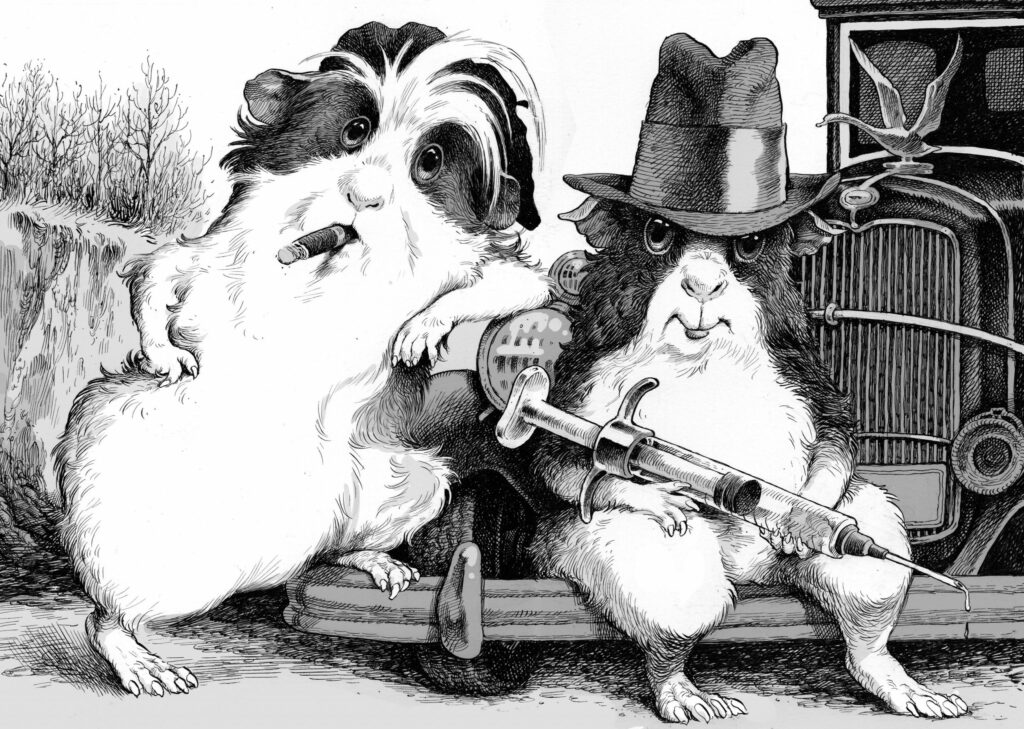Throughout the pandemic, it has been common to hear certain anti-vaxxers proclaim their refusal to be used as experimental “guinea pigs” by malevolent scientists. Given how belligerent the most extreme of these folks generally are, it is unlikely that anyone would mistake them for the placid, affectionate, and highly social animals that go by that name. A misnomer, really, since the small furry creatures don’t come from the country of Guinea nor are they pigs. They are members of a different mammalian family altogether: the Caviidae. This very ancient branch of rodents has only nineteen members, including the long-legged Patagonian mara and the dog-sized capybara — a pair of which escaped from Toronto’s High Park Zoo in May 2016 and enthralled the city for weeks before being recaptured. Their adventures earned them the monikers Bonnie and Clyde.
Like their capybara cousins, domestic guinea pigs, known to breeders as cavies, are often mistaken for run-of-the-mill rodents because they need to gnaw on stuff all day long to keep their perpetually growing front teeth a manageable size. But most rodents have tails, and these critters don’t — at least, not externally. Like humans, they have vestigial tailbones at the base of their spines. Also like humans, they are born with their eyes and ears fully developed, ready to interact with the world. Gregarious beasts, they do best living with companion animals or with devoted owners who interact with them frequently. They purr when contented, love to be played with, and are protective of their young — not necessarily characteristics I’d associate with ardent anti-vaxxers, despite their strident claims that by refusing to get jabs, they are defending their children from a fate worse than COVID‑19.
Vaccination has been a controversial subject since it was invented in China in the year 1000. The practice became more common on a global scale after Lady Mary Wortley Montagu brought it to England from the Ottoman Empire. She herself had nearly died from smallpox in 1715; the disease had a case fatality rate of around 30 percent, which means it killed three out of every ten who got it, including her favourite brother. Of course, such estimates are always unreliable; we don’t even know the real case fatality rate of the latest coronavirus. But we do know with certainty that smallpox was both more contagious and more fatal.
I am going to tell you a thing, that will make you wish yourself here. The small-pox, so fatal, and so general amongst us, is here entirely harmless. . . . There is a set of old women, who make it their business to perform the operation, every autumn, in the month of September, when the great heat is abated. People send to one another to know if any of their family has a mind to have the small-pox; they make parties for this purpose, and when they are met (commonly fifteen or sixteen together) the old woman comes with a nut-shell full of the matter of the best sort of small-pox, and asks what vein you please to have opened. She immediately rips open that you offer to her, with a large needle (which gives you no more pain than a common scratch) and puts into the vein as much matter as can lie upon the head of her needle, and after that, binds up the little wound with a hollow bit of shell.

Sundry adventures in rodentology.
David Parkins
Lady Mary was so impressed that, without telling her husband, she had their three-year-old son inoculated using this technique, known as variolation, before the family was called home a year later. In 1721, when there was another smallpox outbreak in England, she had her second child, a daughter, inoculated by Dr. Charles Maitland in front of King George I’s personal physician. When the girl thrived, others began asking to have their children inoculated as well.
Smallpox remains, to this day, the only human epidemic disease that has been successfully eradicated. The last natural case was reported in Somalia in 1977.
When I was growing up in Montreal in the 1950s, parents practised a method akin to that of those eighteenth-century Turkish ladies, hosting “chicken pox parties” during which sick tots were encouraged to suck on lollipops that were then passed to their uninfected playmates. The belief was that having the disease when you were young and resilient would prevent you from getting a much worse case when you were older. Of course, this was before the varicella vaccine was widely adopted in the mid‑’90s. Today, a routine shot is accepted by sensible people to be much safer for children than getting the disease.
Like lollipops, cavies remain popular in Peru, where they are known as cuyes and are sold roasted on skewers, horrifying as that may be to those of us who love them. Basically, any animal can be a pet to one person and food to another, including dogs (China, Switzerland, Vietnam, Nigeria, Ghana, Burkina Faso, and among the Kickapoo in North America), cats (Korea, Switzerland, China, Vietnam, Taiwan, and Hawai‘i), and horses (France, Mexico, Switzerland, Kazakhstan, Mongolia, Russia, Tonga, Belgium, Japan, Germany, Iceland, Indonesia, Poland, China, and here in Canada). This should not be a surprise, given that cannibalism is still reportedly practised in some parts of the world, including Papua New Guinea, Fiji, and Liberia, as well as on American television.
In fact, scientists have determined that cavies did not evolve naturally in the wild but were domesticated around 7,000 years ago by Andean people when they settled in one place and needed an accessible source of meat. Guinea pigs weigh only about a kilogram and grow to between twenty and fifty centimetres in length, so housing them is not a big burden; because they are vegetarian, feeding them is not particularly onerous; and since a female cavy becomes fertile at one month and can give birth to a litter of up to eight pups five times in her first year (after which she should be retired for health reasons), breeding them is equally easy. Perhaps not as easy as growing potatoes, which often resemble cavies in size and shape, but with more nutritional bang for your buck.
The origin of the name “guinea pig” is contentious. The most common story, however apocryphal, is that the first part derived from the price the animal fetched when it was initially brought to England in the sixteenth and seventeenth centuries: a guinea (one pound and one shilling); and that the second part comes from the squealing sound typical of excited cavies when they smell something yummy or want to be picked up. Britannica suggests a few other origin stories. The name may be a mispronunciation of Guiana, the South American region where some cavies were collected. Or the animals found themselves in Europe after being transferred to ships in ports in Guinea, in West Africa. Or they travelled aboard a class of ship known as a Guineaman. Both the ports and the ships were crucial to the transatlantic slave trade, a fact from which outspoken anti-vaxxers could undoubtedly derive some rhetorical satisfaction if they read up on the animals they fear resembling.
Appreciation of guinea pigs is widespread in Western society. A cavy is the first creature to travel to the Wood between the Worlds in C. S. Lewis’s novel The Magician’s Nephew, the sixth book to be published in the Narnia series though a prequel to the others. Rather than deliver it back to the cruel experiments of his uncle Andrew Ketterley, the boy Digory leaves it happily munching grass on the shores of the multiverse, where it probably remains to this day. And, according to Wikipedia, one of the most popular episodes of the original Star Trek, “The Trouble with Tribbles,” was inspired by Ellis Parker Butler’s “Pigs Is Pigs,” a tale of two cavies that breed profligately at a railway station while incompetent bureaucrats keep arguing whether their freight charge should fall into the category of “pigs” or “pets.”
Outside of Peru, guinea pigs generally fall into the pet category (costing about $50 at your local PetSmart). In fact, there are numerous fancier associations. One, the British Cavy Council, recognizes over forty breeds. Another, the American Cavy Breeders Association, accredits just thirteen. Among breeds accepted by both groups are the Abyssinian, the Coronet, the Teddy, and the curly-haired Texel. In competition, cavies are judged according to four poses: flat, bunched, stretched, and proper. Competitors are assessed on aesthetic qualities as well: type, balance, colour, coat, and condition. Its lack of any significant coat must be why neither group admits the poor hairless Skinny Pig, which bears a startling resemblance to the House Hippo, made famous in 1999 thanks to a PSA that warned kids not to believe everything they saw on television (this being before they all joined social media).
Unlike House Hippos, which allegedly slumber sixteen hours daily, Skinny Pigs sleep very little; maybe because cavies are an easy source of prey in the wild, they take several short naps totalling only six hours a day. Also unlike their would‑be doppelgängers, they do not enjoy peanut butter on toast. Which is a pity because, lacking fur, Skinny Pigs need to eat more than other cavies just to keep their body temperature at a comfortable level.
The biggest event in a British pig fancier’s calendar is the Bradford Premier Small Animal Show. “With approximately 2,500 Cavies, Gerbils, Hamsters, Mice, Rabbits and Rats attending the show over two days,” explains its website, “the ‘Bradford’ Premier Small Animal Show is the largest and longest running Small Animal Show in the UK.” The rules governing British cavy shows run to thirteen pages and emphasize scrupulous care of the animals. One clause reads, for example, “When retrieving exhibits from a pen, carefully open the door, lift the cavy with both hands, one under the body, and the other lightly over the top, bringing the exhibit out head first, taking care not to injure the cavy on the door frame, paying special attention to the legs and feet.” Despite such tender-heartedness, guinea pig pageants can be quite cutthroat and are occasionally shaken by scandal when award-winning contestants disappear, allegedly stolen by envious rivals.
Sometimes pigs disappear from other places, like pet stores, backyard pens, schools, and libraries. In July 2021, Mr. Milk and Princess Sparkles were located by police two days after they were stolen from a daycare centre in Queensland, Australia. I was unable to discover anything online about who nicked them, so who knows? Perhaps the missing creatures weren’t lifted carefully with two human hands from their pen but made their own getaway, just as Bonnie and Clyde did in Toronto’s High Park. Perhaps, like the anti-vaxxers, they just wanted to be free.
Susan Glickman is a poet and novelist. She walks her dog, Virginia Woof, around Wychwood Park in Toronto every day.
Related Letters and Responses
@klagowski via Twitter

